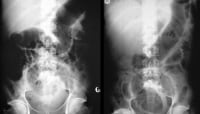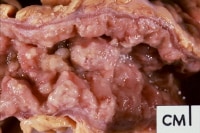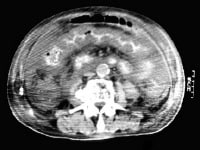Toxic megacolon is the clinical term for an acute toxic colitis with dilatation of the colon. The dilatation can be either total or segmental. A more contemporary term for toxic megacolon is simply toxic colitis, because patients may develop toxicity without megacolon. For the purposes of this article, the term toxic megacolon (toxic colitis) is used, but either toxicity or megacolon can occur exclusively of each other.[1]
The hallmarks of toxic megacolon (toxic colitis), a potentially lethal condition, are nonobstructive colonic dilatation larger than 6 cm and signs of systemic toxicity. Toxic megacolon (toxic colitis)was recognized by Marshak and Lester in 1950.[2] Jalan et al described the diagnostic criteria.[3] The first criterion is radiographic evidence of colonic dilatation. The second criterion is any 3 of the following: fever (>101.5°F), tachycardia (>120 beats/min), leukocytosis (>10.5 103/µL), or anemia. The third criterion is any 1 of the following: dehydration, altered mental status, electrolyte abnormality, or hypotension.
Toxic megacolon (toxic colitis) was first thought to be a complication of ulcerative colitis. In fact, toxic megacolon (toxic colitis) may complicate any number of colitides, including inflammatory, ischemic, infectious, radiation, and pseudomembranous.[4, 5] See the image below.
 A 22-year-old man presented with abdominal pain, passage of blood and mucus per rectum, abdominal distention, fever, and disorientation. Findings from sigmoidoscopy confirmed ulcerative colitis. Abdominal radiographs obtained 2 days apart show mucosal edema and worsening of the distention in the transverse colon. The patient's clinical condition deteriorated over the next 36 hours despite steroid and antibiotic therapy, and the patient had to undergo a total colectomy and ileostomy.
A 22-year-old man presented with abdominal pain, passage of blood and mucus per rectum, abdominal distention, fever, and disorientation. Findings from sigmoidoscopy confirmed ulcerative colitis. Abdominal radiographs obtained 2 days apart show mucosal edema and worsening of the distention in the transverse colon. The patient's clinical condition deteriorated over the next 36 hours despite steroid and antibiotic therapy, and the patient had to undergo a total colectomy and ileostomy.
The incidence of toxic megacolon (toxic colitis) is expected to increase due to the rising prevalence of pseudomembranous colitis. Colonic dilatation may be present in other conditions, such as Hirschsprung disease, idiopathic megacolon/chronic constipation, and intestinal pseudo-obstruction (Ogilvie syndrome). However, these patients do not develop signs of systemic toxicity and, therefore, do not fall into the category of having toxic megacolon (toxic colitis). See the images below.
 Gross pathology specimen from a case of pseudomembranous colitis demonstrating characteristic yellowish plaques.
Gross pathology specimen from a case of pseudomembranous colitis demonstrating characteristic yellowish plaques.  Computed tomography scan from a patient with pseudomembranous colitis demonstrating the classic accordion sign.
Computed tomography scan from a patient with pseudomembranous colitis demonstrating the classic accordion sign.
The hallmarks of toxic megacolon (toxic colitis), a potentially lethal condition, are nonobstructive colonic dilatation larger than 6 cm and signs of systemic toxicity. Toxic megacolon (toxic colitis)was recognized by Marshak and Lester in 1950.[2] Jalan et al described the diagnostic criteria.[3] The first criterion is radiographic evidence of colonic dilatation. The second criterion is any 3 of the following: fever (>101.5°F), tachycardia (>120 beats/min), leukocytosis (>10.5 103/µL), or anemia. The third criterion is any 1 of the following: dehydration, altered mental status, electrolyte abnormality, or hypotension.
Toxic megacolon (toxic colitis) was first thought to be a complication of ulcerative colitis. In fact, toxic megacolon (toxic colitis) may complicate any number of colitides, including inflammatory, ischemic, infectious, radiation, and pseudomembranous.[4, 5] See the image below.
 A 22-year-old man presented with abdominal pain, passage of blood and mucus per rectum, abdominal distention, fever, and disorientation. Findings from sigmoidoscopy confirmed ulcerative colitis. Abdominal radiographs obtained 2 days apart show mucosal edema and worsening of the distention in the transverse colon. The patient's clinical condition deteriorated over the next 36 hours despite steroid and antibiotic therapy, and the patient had to undergo a total colectomy and ileostomy.
A 22-year-old man presented with abdominal pain, passage of blood and mucus per rectum, abdominal distention, fever, and disorientation. Findings from sigmoidoscopy confirmed ulcerative colitis. Abdominal radiographs obtained 2 days apart show mucosal edema and worsening of the distention in the transverse colon. The patient's clinical condition deteriorated over the next 36 hours despite steroid and antibiotic therapy, and the patient had to undergo a total colectomy and ileostomy. The incidence of toxic megacolon (toxic colitis) is expected to increase due to the rising prevalence of pseudomembranous colitis. Colonic dilatation may be present in other conditions, such as Hirschsprung disease, idiopathic megacolon/chronic constipation, and intestinal pseudo-obstruction (Ogilvie syndrome). However, these patients do not develop signs of systemic toxicity and, therefore, do not fall into the category of having toxic megacolon (toxic colitis). See the images below.
 Gross pathology specimen from a case of pseudomembranous colitis demonstrating characteristic yellowish plaques.
Gross pathology specimen from a case of pseudomembranous colitis demonstrating characteristic yellowish plaques.  Computed tomography scan from a patient with pseudomembranous colitis demonstrating the classic accordion sign.
Computed tomography scan from a patient with pseudomembranous colitis demonstrating the classic accordion sign.
ليست هناك تعليقات:
إرسال تعليق